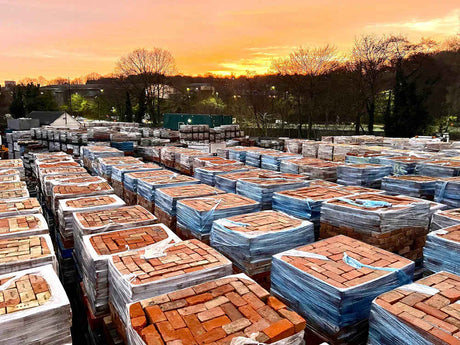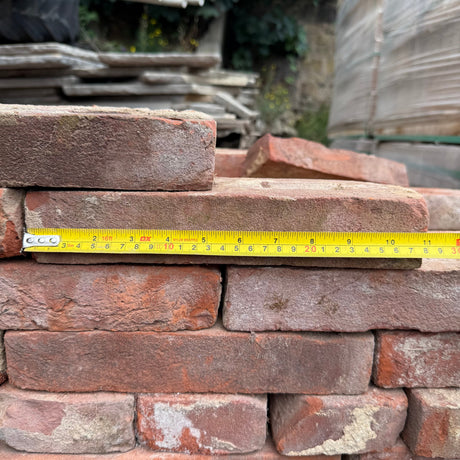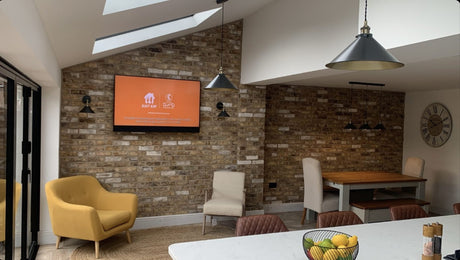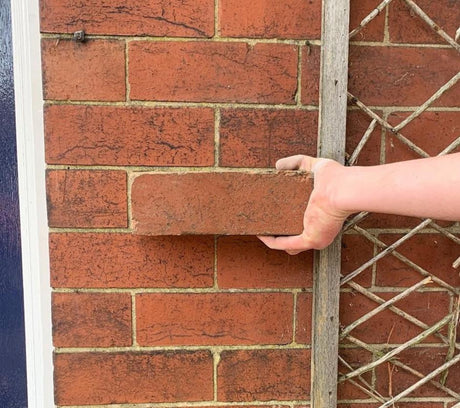Creating a stunning feature wall inside your home can transform the space dramatically. Yet, the thought of dealing with bricks and mortar to create it might seem too challenging for many DIY enthusiasts.
This is where faux exposed brick wall side panels come into play, offering an easier option to achieve that sought-after, exposed brick wall look without the complexity of traditional masonry work.
Did you know that installing decorative faux brick paneling on wall and ceiling panels can be a straightforward do-it-yourself project? That's right. With just a few tools and the materials needed, plus some patience, you can install faux brick paneling and add character to any room in your house.
Our guide will walk you through putting each step—from selecting the right thin layer of brick veneer to using mortar and applying grout—ensuring successful installation from start to finish.
Read on to learn how to install decorative brick wall!
What Materials Do You Need to Install a Faux Brick Wall?
Determining the appropriate brick veneer from a neighbourhood mason is your initial move in establishing an exposed brick wall within your dwelling. You require panels that paint will stick to the wall effortlessly, be it for a fireplace or a single wall in your kitchen.
Search for slim, thin brick veneer or imitation bricks, which are simpler to put in place compared to full bricks yet still endow your area with the texture of genuine brick.
The crucial tools and adhesives encompass construction adhesive, tile spacers to corroborate even spacing amidst panels, and a wet saw to cut any pieces to an impeccable fit. Spreading adhesive evenly across the expanse is facilitated by a trowel.
Wall preparation may necessitate paint or polyurethane if your goal is to shield the base surface. Verify you have these components on hand before commencing the first course of your DIY imitation brick wall endeavour.
Choosing the Right Brick Veneer
Selecting the correct thin brick veneer for your project involves considering both aesthetic appeal and practical functionality. Faux bricks, also known as thin brick or a thin layer of brick with veneer, offer a versatile solution that mimics the look of exposed thin brick, without the weight and structural demands of real bricks.
This makes installation easier, especially for DIY enthusiasts aiming to add warmth and texture to their home's interior walls.
You should choose a veneer from a local mason to ensure it complements your space's existing design elements. It’s crucial to measure the area in square feet (sq, sq ft +) beforehand so you know how much material you need.
With options ranging from traditional reds to more modern greys, there's a style suited for every preference. Once selected, gather your tools and adhesives; hence proceeds preparing the wall surface for panel attachment.
Necessary Tools and Adhesives
For a successful DIY faux brick veneer wall project, selecting the right tools and adhesives is critical. This ensures both ease of installation and long-term durability of your faux brick veneer wall.
-
Measuring tape - Essential for accurate measurements before cutting panels to fit your space.
-
Chalk line - Used for creating straight, level lines on the wall to guide panel placement.
-
Level - Ensures your panels are perfectly horizontal or vertical, depending on the desired pattern.
-
Utility knife - A sharp utility knife makes precise cuts on panels, especially around outlets and corners.
-
Adhesive - High-strength construction adhesive suitable for adhering veneer to a wall ensures a secure bond.
-
Notched trowel - Spreads adhesive evenly on the back of panels or directly onto the wall surface.
-
Drill with screw bits - For securing panels into place when adhesive alone isn’t enough, especially in areas with high pressure or movement.
-
Caulking gun - Aids in applying adhesive with control and precision along edges or in tight spaces.
-
Putty knife or spatula - Helps in smoothing out adhesive and filling gaps between panels for a seamless appearance.
-
Grout bag - Essential for applying grout between the bricks, adding texture and a realistic look to your faux brick wall.
-
Sponge and bucket of water - Necessary for cleaning excess grout off the brick faces without removing it from between bricks.
These tools and other materials needed will help you achieve a professional-looking brick veneer wall inside your home, adding warmth and character to any room.

Preparing the Wall Surface
Ensuring your wall is ready before you start applying faux brick panels is essential for a successful installation. You must clean the surface thoroughly to remove any dust, grease, or loose paint.
This step ensures that adhesives can bond effectively, creating a durable finish on your decorative wall. If the wall has cracks or holes, fill them with wet top plaster and let it dry completely.
Marking the layout accurately is crucial for achieving a professional look. Use a chalk line to create reference points across the space where you plan to install the faux brick paneling.
This technique aids in aligning each panel and tile correctly, ensuring even spacing and straight lines throughout your new brick veneer project.
Proper preparation of the wall surface makes all the difference between an amateur and a polished finish.
How Do You Prepare a Wall for Faux Brick Paneling?
The preparation of your wall for faux brick paneling is vital for achieving a neat, even pressure sustainable faux brick paneling finish throughout. It aids in proper faux brick paneling and adherence, resulting in an appearance similar to authentic real brick throughout.
-
Begin by thoroughly cleaning your wall to eliminate dust, dirt, and grease. The adhesion improves with a cleaner surface.
-
Accurately calculate the area to determine the quantity of faux brick wall paneling you will require. Always allow an extra 10% for waste and trimming.
-
Examine the wall for any defects or blemishes and address them before moving on. Even walls facilitate a smooth application.
-
If required, implement a preliminary layer using materials compatible with your specific type of wall. This stage is critical for surfaces that might not adhere well with the bonding agent.
-
Implement a chalk line to demarcate the placement of each panel, ensuring they are evenly aligned. This aids in maintaining a regular pattern throughout the entire wall.
-
Decide if your setting up process begins at the bottom or top of the wall, considering aspects like electrical outlets and other obstructions.
-
Precisely cut any outlet or switch openings in the panels prior to their application to the wall, using a table saw or utility knife.
-
Strategize any trimming required to accommodate panels around edges or into smaller spaces, ensuring direct adherence on plasterboard or the underlying surface for optimal results.
By adhering to these steps accurately, installing faux brick becomes less challenging. More importantly, your new ornamental brick wall becomes an attractive feature of your home, offering a cosy texture similar to actual bricks without the burden of heavy construction work.
Cleaning and Measuring the Space
Commencing the process with cleaning the target area is the initial phase in creating a remarkable imitation of real brick wall within your home. Eradicate all dust and particles to guarantee a seamless adhesion process.
A spotless surface allows the adhesive to bond adequately with both the plasterboard and the rear of painted walls behind the panel. Assess the wall with precision, using a tape measure to determine the total area.
This laser level of precision is essential for buying an adequate quantity of imitation brick panels from home improvement stores like Home Depot, avoiding surplus.
Following this, accurately mark your layout on the now pristine and prepared wall using a chalk line. This stage determines the placement of each panel, simplifying the installation process to achieve a straight, aligned look.
This is critical for visual allure and for confirming that AC power outlets continue to be accessible after the installation. Proper sizing and marking greatly lessen the time spent trimming panels to accommodate fixtures or fit into corners, making your home improvement task more efficient.
Applying a Base Layer for Adhesion
After ensuring the wall is clean and measurements are precise, in the next post, step 2 and step 3 of 2 and 3 of 2 applying a base layer for adhesion becomes crucial. This step involves preparing the surface so that faux brick panels adhere properly, establishing a strong bond between the wall and full brick panel.
One must use a suitable adhesive that's designed for panelling to ensure longevity. It's essential to spread this adhesive evenly across the back of each panel before positioning them on the wall.
A good foundation ensures your new faux brick wall stands firm.
For best results, select an adhesive that matches both the texture of real bricks and your wall type, whether it's drywall or another material. Before laying out any panels, cover outlets with tape and turn off AC power plugs and sockets to avoid mishaps.
Smooth application paves the way for securing panels firmly in place, transforming any room into a warm space filled with character.
Marking the Layout with a Chalk Line
Marking the floor layout with a chalk line is crucial for ensuring that faux brick panels align correctly on your wall. First, measure the floor space where you plan to install the brick veneer.
Use a level to mark straight lines of mortar across three bricks of the wall. These mortar lines serve as guides for applying panels of mortar evenly across three bricks and maintaining consistent spaces of mortar between bricks.
Next, snap a chalk line along these marks. This step helps in creating clear, straight line and visible lines that guide installation. It's especially important if your wall includes features like windows or doors, where straight line and precision matters for an aesthetically pleasing finish.
Following these guidelines will result in a more professional look, making it seem as though experts installed brick to the wall in your home.

What Are the Steps to Install Faux Brick Wall Panels?
Installing faux brick wall panels adds warmth and texture to your home. This process makes it easier to install compared with real brick walls.
-
Measure the area of the wall in square feet to determine how many panels you need. Include a bit extra for cuts and adjustments.
-
Choose the right brick veneer from a local supplier that fits your interior design vision.
-
Clean the wall thoroughly, ensuring it is free from dust and debris for better adhesion.
-
Apply a primer as a base layer if the wall surface is glossy or non-porous, improving the grip of adhesive.
-
Use a chalk line to mark out your layout directly on the drywall, which guides where each panel will go.
-
Cut panels to fit around windows, doors, or corners using a saw. Always measure twice before cutting.
-
Spread adhesive evenly on the back of each panel with a notched trowel.
-
Position each panel on the wall, starting at the bottom and pressing firmly for good contact.
-
Secure panels with nails or screws in studs for extra support if necessary.
-
Allow sufficient dry time for adhesive according to product instructions; usually 24 hours.
-
Mix grout and apply it into spaces between bricks using a grout bag for that realistic brick wall look.
-
Smooth out grout lines with a damp sponge and clean any excess grout off the brick face before it dries.
These steps offer homeowners and professionals an accessible guide for transforming their space with faux brick panels, creating stunning features like a thin brick accent wall without extensive masonry skills or tools.
Cutting Panels to Fit
Cutting panels to ensure they fit perfectly on your wall requires accuracy and patience. Measure your space carefully, then mark the exact dimensions on the back and left side of the panel. Use a sharp cutting tool for precision, such as a saw suited for faux brick materials.
Always cut in a well-ventilated area to manage dust and wear safety gear.
After cutting, check if each piece aligns with the layout you planned. This step is crucial before adhering them to the wall. Sometimes, adjustments are necessary when dealing with corners painted walls or obstacles like pipes and electrical outlets.
Test fit every panel against its designated spot to avoid surprises later during installation. This approach saves time and ensures your new wall looks professional once complete.
Applying Adhesive and Positioning Panels
Apply a generous amount of adhesive to the back of your faux brick panels. Spread it evenly across the surface, ensuring you cover every corner. This step is crucial for securing the panel firmly to the wall.
Once coated, press and lay the panel against the prepared area on one brick of your wall. Make sure you start at the bottom one square foot of half brick row and work your way up, aligning each piece precisely with its neighbouring panels.
It’s okay to install these directly onto drywall or any other smooth surface that you’ve prepared beforehand.
Next, adjust each panel so that it fits perfectly in its designated spot. You may need to cut some pieces to ensure they fit around corners or under windowsills properly. Use a saw designed for cutting veneer; this will help maintain clean edges and joints and avoid damage.
After positioning, press down firmly along every part of the panel to enhance adhesion between it and the wall surface. Allow adequate dry time as recommended by your adhesive's manufacturer before moving on to grouting or painting over them if necessary.

Securing Panels and Allowing Dry Time
Ensure each panel adheres firmly to the wall completely dry, by applying pressure evenly across its surface. Use a rubber mallet if necessary to gently tap the panels into place, ensuring a secure and flush fit against the wall periodically the drywall.
Securing your faux brick panels properly prevents future shifts or gaps, keeping your wall looking impeccable.
Allow sufficient dry time for the adhesive, typically 24-48 hours, before moving on to grouting. This patience ensures a strong bond that will support the weight of your faux bricks over time.
As you wait next brick out, consider planning your grout colour and technique to give next brick in second row of your wall an authentic brick appearance.
Patience in letting the adhesive dry fully pays off with a sturdy and visually appealing brick veneer finish.
How Do You Grout Faux Brick Walls?
Implementing grout on faux cement and brick walls is a straightforward yet indispensable task to realise the aspirational look of an indoor brick wall. This procedure addresses the spaces we create between bricks, cement and mortar, cement and mortar, augmenting both aesthetics and longevity.
-
Calculate the needed quantity of grout by assessing the square footage of your faux brick wall. An accepted regulation is that 1 kg of grout blankets around 2 square meters for half-brick panels.
-
Prepare the grout as per the producer's guidelines. Strive for a viscosity akin to peanut butter, ensuring effortless application without spillage.
-
Fill a grout bag halfway with the prepared grout. This implement resembles a large icing bag and allows for accurate regulation during grout application.
-
Force the bag gently to disperse grout into the interspaces among faux bricks. Initiate from one corner of the wall and progress your way across for uniform distribution.
-
Employ a pointing tool or your gloved finger to compact the grout, ensuring all crevices are adequately filled.
-
Erase any surplus grout from the top of faux bricks using a damp sponge. Frequent rinsing of the sponge in pure water helps bypass smearing.
-
Leave the applied grout to harden for roughly 30 minutes or as suggested by its packaging before initiating clean-up.
-
Post initial hardening, examine the masonry with a clean, slightly damp sponge to eliminate any mist left on the bricks' surface from the grouting procedure.
-
Allot your brick wall undisturbed for a minimum of 48 hours, enabling the grout to fully solidify and adhere securely to your wall.
This ultimate touch not just stabilises your faux brick panels but additionally injects warmth and genuineness, causing difficulty in discerning real brickwork upon concluding these steps accurately and attentively.
Mixing the Grout Properly
To achieve a refined brick finish, for your imitation brick walls, correctly blending the grout is first course a principal task. in step 3. 1 Commence following the guidelines provided by the product manufacturer to obtain the optimum consistency that should mirror the thickness of dense peanut butter.
Such viscosity guarantees its efficient adherence between bricks, setting up a resilient union. In step 2 ,Utilise clean water and blend gently to avert air cavities, which might diminish the grout line's strength over the course.
In step 1 of 3 ,Once you've blended, let the grout rest for around 10 minutes prior to beginning the application process. This rest interval allows the constituents to completely amalgamate which escalates workability.
Operate in smaller sections to maintain management of both the application process, and drying durations, making sure each gap between the bricks fills homogeneously for a consistent look across your ornamental brick wall or stone veneer project.
Applying Grout with a Grout Bag
Using a grout bag to apply grout between your faux brick wall panels is similar to using a piping bag in baking. You fill the bag with mixed grout and then squeeze it into the spaces between the bricks.
Make sure you fill every gap thoroughly for a solid brick finishing throughout the house. This method gives you more control and keeps things neat, reducing mess on the exposed brick faces.
After filling the gaps, take a damp sponge or cloth to wipe away any excess grout from the brick surface immediately. This step prevents the grout from drying on the bricks, which can be tough to remove once set.
For larger projects inside homes or commercial spaces, this approach ensures that your brick wall inside remains clean and professional-looking throughout the installation process.
Smoothing Grout Lines and Cleaning Excess
After you've applied grout with a grout bag, the next step ensures your faux brick wall looks professional. Smooth out the grout lines for an even finish. Use a damp sponge or cloth to wipe away any excess grout that adheres to the wall or bricks.
Be sure to work quickly before the grout dries and completely dry it.
For cleaning up, always have a bucket of water and a clean sponge on hand. This helps remove unwanted grout from the surface of your faux brick panels. Regular rinsing of the sponge in fresh water keeps it effective in lifting off surplus material without smearing it back onto newly-installed bricks.
This careful attention is key in achieving a clean, authentic look for even pressure full brick of your decorative brick wall.
How Can You Maintain and Clean a Decorative Brick Wall?
Keeping your decorative brick wall in top condition requires regular dusting and cleaning. Use a soft brush to remove dust from the bricks and keep the entire wall looking fresh. For tougher stains, mix water with a mild detergent and gently scrub the affected area until clean.
Be careful not to use harsh chemicals or abrasive tools, as these can damage the bricks.
To tackle spills immediately, blot them with a clean cloth to prevent staining. Periodically check for damaged panels and repair them promptly to maintain the wall's appearance and structural integrity.
Following these steps will ensure your faux brick brings warmth to your home for years to come.
Now the next blog post is for time consuming this blog post let's explore about how to install decorative brick wall so you can add even more style around your decorative brick wall.

Regular Dusting and Cleaning
To keep your faux brick wall in pristine condition, regular dusting and cleaning are essential. Dust accumulates over time, dulling the vibrant look of the bricks. Use a soft brush or microfibre cloth to gently remove surface dust.
For deeper cleaning, mix a mild detergent with water and use a soft sponge to wipe down the panels carefully. Avoid harsh chemicals as they can damage the surface of your faux brick.
Handling stains and spills swiftly prevents them from becoming permanent marks on the tile or your wall. A simple solution of water and mild soap often does the trick for most stains. Rinse with clean water and dry with a soft cloth to maintain the appearance of your tile or faux brick wall.
Love your wall by giving it the care it needs.
The next step involves handling more challenging tasks such as repairing damaged panels to ensure longevity and sustained aesthetic appeal.
Handling Stains and Spills
Addressing spills and stains on your artificial brick wall shouldn't cause worry. Initiate by lightly dabbing any spilled liquid immediately, this stops the liquid from penetrating deeper into the panels.
A fresh, moist cloth will suffice for this task. For more resistant stains, combine a mild cleaning agent with water and place it on slightly damp rag directly on the problematic area. Excessive rubbing slightly damp rag can ruin the bricks' surface, thus always scrub lightly.
Regular upkeep is critical for your decorative brick wall to maintain its pristine appearance. If grease lands on the kitchen's artificial brick wall panels – potentially one positioned behind an appliance or on the left side adorned with these fashionable veneers – a mixture of vinegar and water can be effective.
Simply spritz it onto the greasy areas and clean off after a couple of minutes. Whether confronted with spilled wine or cooking oil splatter, swift attention to these accidents ensures they do not permanently tarnish your stunning artificial brick feature wall.
Repairing Damaged Panels
Repairing damaged panels is straightforward if you have the right approach. Start by removing any loose pieces from the surface. Apply a generous amount of adhesive to the back of a new faux brick piece and press it firmly into place on the wall.
Ensure it adheres well to cutting bricks by applying pressure evenly across its surface. Let this dry completely before applying grout around the edges to blend it with existing cutting bricks well.
For deeper scratches or dents, fill them with a suitable filler before painting over them to match your new wall part's colour. Always test paint colours on a small section first to ensure they blend seamlessly with existing panels.
Keeping one brick in your faux brick wall looking fresh involves regular maintenance and timely repairs.
Conclusion
Refurbishing a room with imitation brick wall panels is easier than perceived. This manual illustrates how to select the suitable veneer, prep your area, and efficiently position the panels.
The procedure economises on time and bestows an attractive allure to any place. To refine your competencies further, viewing YouTube tutorials or exploring Instagram for motivation could be beneficial.
Acting upon your designing concepts actualises them. Proceed and lend one wall in your kitchen that classic brick aesthetic.








